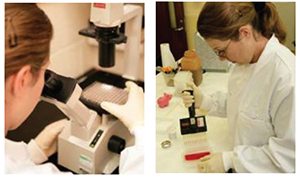Voluntary Code for Stallion and Mare Owners
The Horse Sport Ireland (HSI) Voluntary Code of Practice for Stallion and Mare Owners outlines voluntary recommendations to help breeders, in conjunction with their veterinary surgeons, to prevent and control specific equine diseases. Prevention of disease is of the utmost importance for increasing fertility rates and avoiding adverse economic and welfare situations. HSI would like to encourage stallion and mare owners to follow the voluntary guidelines outlined in this Code of Practice in order to minimise the incidence of infectious diseases in the Irish Sport Horse sector.
 The HSI Voluntary Code of Practice covers a number of diseases:
The HSI Voluntary Code of Practice covers a number of diseases:
- CEM (Taylorella equigenitalis)
- EVA (Equine Viral Arteritis)
- EIA (Equine Infectious Anaemia)
- Equine Herpes Virus
CEM (Taylorella equigenitalis)
CEM is a venereally transmitted bacterial disease. It is a Notifiable Disease and has been found in non-Thoroughbreds in Europe and in the USA and Canada. CEM is highly contagious and can be difficult to detect and control as animals may be asymptomatic. When coupled with the fact that mares can be bred only during certain seasons, CEM can have a devastating effect on equine reproductive efficiency.
Clinical signs
Stallions that are infected with CEM do not show any clinical signs. Clinical signs for
infected mares vary from acutely infected mares, who may display an obvious thick, milky, mucoid vulvar discharge 10 to 14 days after breeding, to carrier mares, who may not display any clinical signs of infection.
Transmission
CEM can be transmitted during covering/teasing and through the use of infected semen (chilled or frozen) or unhygienic procedures.
Prevention and control
- Owners should have their mares and stallions tested for CEM at the beginning of each breeding season. This involves a veterinary surgeon taking swabs from the genitalia of mares and stallions.
- Stallion owners/handlers should use disposable AV liners, cleaned adequately between uses, and should not share AVs between stallions. A disposable protective barrier on the rear of the breeding mount (where the penis contacts) should also be used during collection and changed between stallions.
- The breeding mount should be washed with a suitable agent (e.g. Chlorhexidine) between stallions and an antibiotic extender (or an antibiotic to which the organism is not sensitive) should be used. It should be noted that even with the use of a suitable antibiotic, transmission may still occur.
- Stallion owners/handlers should not share penis washing equipment without sterilisation in between stallions or good aseptic technique (this includes hands, e.g. use of disposable latex gloves that are discarded after washing and/or guiding the penis, or thorough scrubbing of the hands with a suitable bactericide in between collections/breedings).
- In the event of a mare/stallion testing positive for CEM the owner should:
1. Notify the Department of Agriculture
2. Seek veterinary advice
3. Stop covering. This includes the use of A.I.
4. Check and swab all other mares/stallions that were covered
5. If semen has been sent out, notify the relevant people
6. Do not resume breeding activity or collection of semen until an attending veterinary surgeon or the Department of Agriculture is satisfied that there is no further threat
Other venereally transmitted bacterial diseases include Pseudomonas aeruginosa and Klebsiella pneumoniae, which are not notifiable but many cases are found each year.
EVA (Equine Viral Arteritis)
Outbreaks of EVA have occurred all over the world including the UK, France and the USA. As there is no mandatory testing for EVA before importation from EU member states there is a constant risk of importing this virus into Ireland. EVA is a Notifiable Disease.
Clinical Signs
The clinical signs associated with EVA are extremely variable and range from subclinical disease with reduced fertility to severe disease with abortion in pregnant mares and death of young foals. The most commonly observed clinical signs include fever, depression, a decrease in appetite, oedema (swelling) of the limbs, the mammary gland of mares, the scrotum of stallions and around the eye socket, stiffness in gait, inflammation of conjunctiva (‘pink eye’) and nasal mucous membranes, skin rashes and ocular and nasal discharge. A mare may abort without showing any other clinical signs.
Transmission
Viral transmission occurs primarily by stallions during mating or artificial insemination. Approximately 50% of the stallions that are exposed to the virus become long-term venereal shedders. Such stallions infect every mare they cover.
After being exposed to the virus a mare may shed it in all of her bodily fluids for up to a month. At the end of this period she is no longer infectious and is safe to breed. However, for the period that she is shedding the virus she may infect other horses by direct contact or by aerosol (infected droplets from the respiratory tract). Initial venereal infection is frequently followed by extensive virus spread by the respiratory route. A stud farm that introduces a carrier or uses infected semen can quickly end up with several longterm carrier stallions.
Prevention and control
- Stallions should be tested for EVA prior to importation.
- When importing semen for AI it must be established, through requesting an EVA certificate, that the donor stallion was not shedding virus at the time of collection.
- Stallions that were originally imported for competition purposes should be tested for EVA should they subsequently be used to cover mares/semen collection.
- All stallions standing in Ireland, including teasers, should be vaccinated prior to the start of the breeding season and sixmonthly boosters are required. Stallions and teasers should also be blood tested before the breeding season.
- Stallion owners should insist that mares be blood tested for EVA within 4 weeks before mating.
- EVA is a Notifiable Disease in Ireland. If it is suspected, breeding activities must cease immediately and the Department of Agriculture must be notified.
EIA (Equine Infectious Anaemia)
There is a high incidence of outbreaks of EIA in Romania and recent cases in other EU countries indicate that there is a risk of the virus spreading from mainland Europe. In 2006 an outbreak occurred in Ireland and more than 1,500 horses were subject to movement restrictions by the Department of Agriculture. EIA is a Notifiable Disease.
Clinical signs
The clinical signs of EIA are extremely variable. In Ireland in 2006 some horses were acutely affected and died from the disease, while others showed no clinical signs. The acute form of the disease is characterised by fever, depression, increased heart and respiratory rates, incoordination and rapid weight loss. Other non-specific signs such as nasal discharge may be observed during the
initial episode of the disease. Chronic cases are characterised by recurring cycles of anaemia, swellings, weight loss and loss of energy interspersed with periods of normality. Recurrences are often stress related. Some animals show no clinical signs or are so mildly affected that their condition goes unnoticed by their owner.
Transmission
Transmission of EIA usually occurs by the transfer of blood or secretions containing infected cells. The virus can be transmitted by biting flies, particularly horse flies (EIA is sometimes referred to as ‘Swamp Fever’ as it is most prevalent in warm wet areas where flies are abundant). Transmission can also occur through contaminated needles, teeth rasps, stomach tubes, twitches, curry combs
or any other instruments which may cause abrasion.
Prevention and control
- There are no vaccines available for protection of horses against EIA. All infected horses remain virus carriers for life and can serve as a source of infection for other horses. Eradication of the disease involves identifying infected horses and removing them (usually by slaughter) from the population.
- Horse owners should blood test their horses to establish their EIA status and screen all incoming horses prior to introduction to their premises.
- During the breeding season all mares should be tested before acceptance on the stud farm.
- All veterinary equipment and other instruments that are capable of causing abrasion should only be used on an individual horse prior to disposal, or appropriately sterilised between horses.
- Outbreaks of EIA have been recorded in serum production horses. It is illegal to import plasma or other blood products from other countries without Department of Agriculture authorisation. The EIA status of the donor horse must always be established by blood testing.
- EIA is a Notifiable Disease under the Diseases of Animals Act and anyone who owns, manages, or examines a horse which is infected, or is suspected of being infected, must notify the Department of Agriculture.
EQUINE HERPES VIRUS
Both Equine Herpesvirus 1 and 4 (EHV-1 and 4) cause abortion in mares and are common in
horse populations worldwide. Sporadic and multiple abortions due to EHV-1 infection occur during each breeding season. Occasionally, all of the pregnant mares on a premises abort. The virus is occasionally associated with a neurological disease, which can be fatal. EHV-4 is a less serious pathogen than EHV-1, but is associated with the sporadic cases of abortion during most breeding seasons.
Clinical signs
Most EHV associated abortions occur without any warning signs and during the last third of pregnancy. Abortions sometimes occur as ‘red-bag’ where there is premature separation of the placenta. Foals may be carried to term and born alive but infected. Such foals are usually sick at birth or develop respiratory disease within 48 hours. They may be jaundiced.
EHV-1 is also associated with a neurological syndrome which can be fatal or necessitate euthanasia on welfare grounds. Clinical signs vary from mild incoordination followed by complete recovery to fatal paralysis. The most common signs are hind limb incoordination and urinary incontinence.
Transmission
EHV-1 and 4 are spread by the respiratory and not the venereal route. Mares in mixed yards
are most at risk as horses or ponies can be exposed to the virus at race meetings, shows,
hunts or sales and serve as a source of infection for brood mares.
Equine Herpes viruses have the ability to establish a latent infection. This is where they are harboured in a non-active state but can reactivate and multiply at any stage during the horse’s lifetime. Stress factors such as transport over long distances in late pregnancy or pain due to lameness or other causes may induce a reactivation of latent virus and precipitate abortion. The mare that experiences the reactivation may not abort herself but may serve as a source of infection
to other in-contact pregnant mares. Foetuses aborted as a result of EHV infection are heavily contaminated with the virus. Thus multiple abortions often follow the abortion of a foetus in a field where several pregnant mares are grazing.
Prevention and control
- Pregnant mares should be kept separate from other horses and if possible, foaled at home. It is important to minimise stress to pregnant mares. All pregnant mares, particularly those that have travelled long distances and those from sales yards, should be isolated on arrival at a farm.
- The regular use of an EHV-1 and 4 vaccine during each gestation period is recommended. Mares should be vaccinated at 5, 7 and 9 months of pregnancy.
- All cases of abortion, still birth or foal death within 14 days of birth should be treated as suspect virus abortion. Veterinary advice should be sought and the foetus or dead foal submitted to the Irish Equine Centre for investigation.
- The mare that has aborted should be placed in isolation.
- If the mare aborted in a stable the bedding should be disinfected and destroyed. If she aborted in a field in the company of other mares, these mares should be isolated until the laboratory investigation is completed and veterinary advice is obtained.
- If EHV is confirmed all pregnant mares must remain on the infected farm until they foal. Otherwise there is a risk that
they will abort on another premises and spread the virus. Veterinary advice should be sought concerning the movement of
other horses. - No pregnant mares should be allowed on the infected premises once EHV is suspected/confirmed as there is a risk that they will contract the virus and lose their foals.
- If the neurological form of EHV is suspected seek veterinary advice, stop breeding and all movement on and off the
premises.
In summary
The HSI Voluntary Code of Practice for Stallion and Mare Owners recommends that breeders should:
- Vaccinate all pregnant mares against Equine Herpesvirus (EHV)
- Vaccinate stallions against Equine Viral Arteritis (EVA)
- Stallion owners should request that mares are blood tested for EVA and Equine Infectious Anaemia (EIA) prior to arrival on their premises
- Mares and stallions should be tested for venereal diseases at the start of the breeding season
For the importation of horses or semen it is recommended that:
- Prior to importation stallions should be tested for EVA and bacterial venereal pathogens
- Imported semen should be certified as EVA and pathogen free
- Horses are tested for Equine Infectious Anaemia (EIA) prior to importation
Acknowledgements
The HSI Voluntary Code of Practice for Stallion and Mare Owners has been produced by the Irish Equine Centre.
Horse Sport Ireland would like to thank Professor Tom Buckley and Professor Ann Cullinane, Irish Equine Centre, for their assistance in developing the Code of Practice.


















